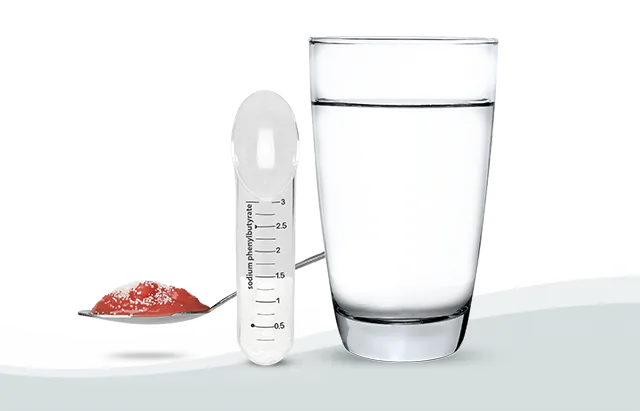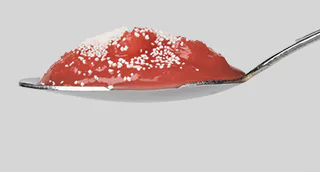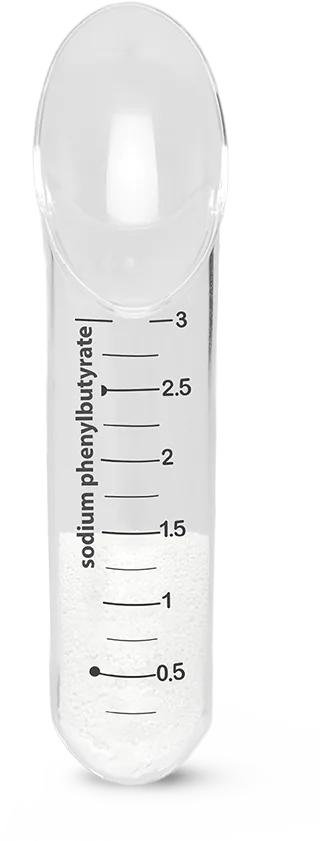How to Take Pheburane®
Every package of Pheburane® comes with its own specially calibrated reusable dosing spoon. Only use this dosing spoon to measure your dose.
2 Ways you can take Pheburane®. Plan to take your Pheburane® dose at the same time as food consumption (meal or snack):
- Swallow with a drink such as water, fruit juice, or protein-free infant formulas.
- Sprinkle onto a spoonful of apple sauce or carrot puree* and swallow immediately. It is important to swallow right away (within 10 seconds) to prevent the coating from starting to dissolve.
*Taking Pheburane® with other foods has not been studied and is not recommended. Pheburane® should only be taken with soft foods if the child is old enough to eat soft foods.
844-884-5520

Suggested Tips When Taking Pheburane®
You can take your divided mealtime dose in one mouthful or little bit at a time until the whole dose has been taken.
Be sure to always pour Pheburane® into the tube portion of the dosing spoon.
- Do not chew Pheburane® oral pellets directly or mix the coated pellets into liquids.
- Avoid the Bitter Taste
Pheburane® coated pellets must be swallowed within 10 seconds to prevent the coating from starting to dissolve.
- Miss a Dose?
If you miss a dose of Pheburane®, take it as soon as possible. Each dose of Pheburane® should be taken at least 3 hours apart. If you have missed a dose within 3 hours of the next dose, take only one dose the next time it is scheduled.
See “How to Take Pheburane®” Patient Guide for downloadable step-by-step instructions on how to measure and take a dose of Pheburane®.

Before Taking Pheburane®
- Always take Pheburane® exactly as your healthcare provider has told you.
- The total daily dose of Pheburane® must be divided into equal doses and taken at the same time as food consumption (meal or snack).
- Only use the calibrated dosing spoon provided with your Pheburane ® package to measure your dose.
- Talk to your healthcare provider or pharmacist if you have any questions on how to take a dose of Pheburane®.
Read the Offical Instructions for Use before taking Pheburane® oral pellets and each time you get a refill.
How to Measure and Take Pheburane®
Repeat steps 1 through 3 throughout the day as prescribed by your healthcare provider to get the total daily dose.

>1.
Use the calibrated dosing spoon to measure the prescribed divided dose of Pheburane® coated oral pellets.
- Lines on calibrated dosing spoon measure Pheburane® (sodium phenylbuyrate) in grams
- The calibrated dosing spoon dispenses up to 3 g of sodium phenylbutyrate, in increments of 0.25 g.
Be sure to always pour Pheburane® into the tube portion of the dosing spoon.
Pour the coated pellets directly into the spoon until it reaches the black line for the prescribed dose of sodium phenylbutyrate in grams.
>2.
2 Ways you can take Pheburane® >
>3.
>Or


Suggested Tip when Taking Pheburane®
- You can take your divided mealtime dose in one mouthful or a little bit at a time until the whole dose has been taken.
If the prescribed divided dose is more than 3 grams, repeat steps 1 through 3 to get the prescribed divided dose of sodium phenylbutyrate.
Do not chew Pheburane® oral pellets directly or mix the coated pellets into liquids.
Avoid the Bitter Taste
It is important to swallow right away (within 10 seconds) to prevent the coating from dissolving.
Miss a Dose ?
If you miss a dose of Pheburane®, take it as soon as possible. Each dose of Pheburane® should be taken at least 3 hours apart. If you have missed a dose within 3 hours of the next dose, take only one dose the next time it is scheduled.
Do not take a double dose to make up for a forgotten dose.
If you take too much Pheburane®, call your healthcare provider or Poison Help line at 1-800-222-1222, or go to the nearest hospital emergency room right away.
Do not give or take Pheburane® through a gastrostomy or nasogastric tube.
Keep Pheburane® and all medicines out of the reach of children.
Do not use the calibrated spoon to measure any other medicine.
If cleaning is necessary, rinse the calibrated spoon with water and dry it quickly.
To replace the calibrated dosing spoon, contact Medunik USA at 1-844-884-5520.
844-884-5520
Important Safety Information
What is Pheburane®Important Safety Information
What is Pheburane®Important Safety Information
What is Pheburane®?
- Pheburane® is a prescription medicine, used along with a specific diet, for the long-term management of adults and children with urea cycle disorders (UCDs), involving deficiencies of carbamylphosphate synthetase (CPS), ornithine transcarbamylase (OTC) or argininosuccinate synthetase (AS).
- Episodes of sudden, rapid increase of ammonia in the blood (acute hyperammonemia) may happen in people during treatment with Pheburane®. Pheburane® is not used for the treatment of acute hyperammonemia, which can be life-threatening and requires emergency medical treatment.
Beforetaking Pheburane®, tell your healthcare provider about all of your medical conditions, including if you:
- have heart problems.
- have kidney or liver problems.
- have diabetes (Pheburane® contains sucrose), or have a history of fructose intolerance, glucose-galactose malabsorption, or sucrose-isomaltase insufficiency.
- are pregnant or plan to become pregnant. It is not known if Pheburane® will harm your unborn baby.
- are breastfeeding or plan to breastfeed. It is not known if Pheburane® passes into your breastmilk. Talk to your healthcare provider about the best way to feed your baby during treatment with Pheburane®.
Tell your healthcare provider about all the medicines you or your child take, including prescription and over-the-counter medicines, vitamins, and herbal supplements.
Certain medicines may increase the level of ammonia in your blood or cause serious side effects when taken during treatment with Pheburane®. Especially tell your healthcare provider if you or your child take:
- corticosteroids
- valproic acid
- haloperidol
- probenecid
Know the medicines you take. Keep a list of them to show your or your child’s healthcare provider and pharmacist when you get a new medicine.
What are the possible side effects of Pheburane®?
Pheburane® can cause serious side effects, including: Nervous system problems (neurotoxicity).
Call your healthcare provider right away if you get any of the following symptoms during treatment with Pheburane®:
- sleepiness
- tiredness
- lightheadedness
- vomiting
- nausea
- headache
- confusion
Low potassium levels in your blood (hypokalemia). Your healthcare provider will monitor your blood potassium levels during treatment with PHEBURANE and treat if needed.
Conditions related to swelling (edema).Pheburane® contains salt (sodium), which can cause swelling from salt and water retention. Your healthcare provider will decide if PHEBURANE is right for you if you have certain medical conditions that can cause swelling, such as heart failure, liver problems or kidney problems.
The most common side effects of Pheburane® include:
- absent or irregular menstrual periods
- decreased appetite
- body odor
- bad taste or avoiding foods that you ate prior to getting sick (taste aversion)
Your healthcare provider may do certain blood tests to check you or your child for side effects during treatment with Pheburane®.
These are not all the possible side effects of Pheburane®.
Call your doctor for medical advice about side effects.
You are encouraged to report negative side effects of prescription drugs to the FDA. Visit www.fda.gov/medwatch. or call 1-800-FDA-1088.
Please read the Full Prescribing Information, the Patient Information. and the Instruction for Use. before taking Pheburane® oral pellets and each time you get a refill.


